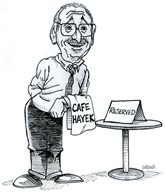GMU Econ alum Dominic Pino reports that “tariff lobbyist spending is up 277 percent over last year.” Two slices:
Some manufacturing firms have been cutting jobs in response to tariffs’ raising their input costs, and the overall economy has been hammered by uncertainty, with a plummeting stock market coinciding with a declining dollar and higher Treasury bond yields. But you can always count on protectionism to be a full-employment program for lobbyists in Washington, D.C., and the Trump administration’s tariff plan is no exception.
An analysis, by Advancing American Freedom, of lobbying disclosures filed with the clerk of the House of Representatives found that lobbying expenditures on trade issues were $4.9 million in the first quarter of 2025. That’s 277 percent higher than the $1.3 million spent in the first quarter of 2024.
…..
Tariffs are great for Washington insiders. They’re not so great for the American people, who will pay higher prices and, in some cases, lose their jobs because politicians and bureaucrats decided they knew best how to arrange trade.
Fortunately, there’s a more effective, expansive, and less disruptive way of securing lowered tariffs and trade barriers. Rather than hurling tariff thunderbolts to get the attention of US trade partners, President Trump should invite them to negotiate free trade agreements (FTAs).
FTAs aren’t new. Indeed, since signing its first such agreement (with Israel) in 1985, the United States has concluded FTAs covering 20 countries. Under such agreements, signatories agree to reduce their tariffs and other trade barriers (see chart) covering substantially all trade with certain limited exceptions. The reductions are reciprocal, and all sides agree on a common set of rules.
Scott Lincicome’s voice continues to be among the clearest and wisest on trade and trade policy. A slice:
Furthermore, many alleged nontariff barriers Trump is targeting aren’t actually trade barriers at all or, in the case of domestic tax and regulatory policy, are considered sovereign domestic (not trade) policies or cultural priorities not up for negotiation—at least not quickly. Other “cheating” is, like “dumping” and intellectual property theft, overblown (at best) and already disciplined by U.S. law. And, of course, the U.S. government does a lot of this stuff too (see, e.g., our trillions in subsidies)—often more so than other governments. Throw in the simple fact that basic politics makes it hard for democratically elected foreign leaders to be seen as caving to a guy like Donald Trump, and it’s not gonna be an easy slog.
Next, there’s the small matter of what the United States actually wants in these deals. Foreign diplomats tell [Wendy] Cutler, for example, that they lack clarity about the White House’s priorities—a necessity for focusing negotiators’ efforts during highly accelerated talks. Others report similar concerns from both the European and Japanese teams as to the U.S. demands and objectives. Is it tariff cuts, nixing nontariff barriers, reducing trade deficits, guaranteeing purchases of U.S. goods, countering China, or something else? And is the U.S. side willing to give on anything, including its own trade barriers, reducing “reciprocal” tariffs below the 10 percent universal rate, or new exclusions like the one Trump quietly announced for consumer electronics?
Sierra Dawn McClain describes Trump’s tariffs as “a kick in the can.” Two slices:
President Trump’s trade policies harm American businesses and consumers. Take one industry—can making—as an example. The president’s game of red light, green light with tariffs creates uncertainty for U.S. can-making businesses and will result in higher prices for canned food and drinks.
Although Mr. Trump on April 9 issued a 90-day pause on reciprocal tariffs and slapped a 10% tariff rate on most goods from most countries, the 25% tariff on steel and aluminum that went into effect on March 12 remains in place. That means higher input costs for U.S. can makers.
…..
Tariffs will generally increase prices by 2 to 5 cents a can, although some specialty cans will increase in price by more than 12 cents. The difference between a can of soup for $3.95 and one for $4 may not sound like much, but small price hikes add up when you’re on a budget.
Not all price increases will be immediate. Corn and peas will be packed after harvest and in some cases may be warehoused for a year, meaning higher prices would show up in 2026. Just-in-time products such as soups are more likely to face immediate price increases.
In addition to the downstream effects for consumers, the trade war creates an environment that makes it harder for American businesses to plan and invest. Mr. Huether of Independent Can Co. had expected to invest $6 million this spring in equipment to build a new canning line, but he halted the project after Mr. Trump on “Liberation Day” announced a 20% tariff on the European Union. The EU produces specialty supplies—welders, seamers and other can-making equipment—that Mr. Huether needs for the project and can’t get from the U.S. The 20% tariff raised the project cost to $7.2 million. Even though there’s now a 90-day pause and a 10% tariff rate on most goods from the EU, Mr. Huether said he’s “holding off . . . until we have much more clarification.”
Whatever he thought was going to happen with his tariff announcement, it didn’t, and President Trump is in planless improvisation mode now. But the episode is also of a piece with every other move in his early administration, aimed at exciting conflict, sticking a thumb in the eye of an establishment whose policies he has long criticized (without really understanding them) and, more importantly, that he believes wants his destruction or impoverishment.
The world now faces a known unknown. It may be months or years before a comfortably intelligible trade-policy equilibrium is re-established.
In vain, we search for precedents. By August 1941, Roosevelt inaugurated a trade war with Japan, embargoing its supply of important metals and oil. It took until MacArthur in 1947 to negotiate new terms for our interdependence. A lot of things happened in between.
One day Mr. Trump talks up free-trade deals, the next tariffs as the solution for America’s every problem. But these are really lower-pay-grade issues for the president. His focus is elsewhere—on the death match with his enemies that began with his 2016 election.
Steve Davis talks with Chad Bown and Doug Irwin about Trump 2.0 trade ‘policy.’
The federal lawsuit, filed Wednesday in the U.S. Court of International Trade, challenges President Donald Trump’s use of the International Emergency Economic Powers Act to impose sweeping tariffs. The White House invoked the law earlier this month to address the nation’s large trade deficit created by unfair foreign trading practices, which the presidency considers a national emergency.
The twelve states argue that the president can only invoke the International Emergency Economic Powers Act when a national emergency presents an “unusual and extraordinary threat” from abroad.
One of Mr. Trump’s greatest strengths is the other party’s weakness. The Democrats have collapsed, as has their socialist-led opposition to all things Trump. The Biden presidency looks even worse in retrospect. But a collapsed Democratic Party won’t matter much if the midterm elections are a referendum on Mr. Trump’s power—if the primary goal of the electorate in 2026 is to express anger at high prices.
George Will rightly is highly critical of the so-called U.S. Department of “Education.” Two slices:
Today, there are widespread laments about the diminishment, perhaps to extinction, of the Education Department, although the lamenters cannot connect it with educational improvements since its founding nearly 46 years ago; there having been few, if any. Although the department has been often slathered with high-minded devotion, it was born from a banal political transaction between a notably pious politician and one of the principal causes of the subsequent decline in K-12 education quality.
…..
Today’s K-12 calamity is chronic absenteeism, defined as students missing at least 10 percent of the school year. This is partly an echo of teachers unions’ conniving at the unnecessary and wickedly prolonged school closures during the pandemic. The 2023 Trends in Mathematics and Science Study showed that students’ scores in those subjects have continued to decline since the pandemic.
Education problems abound. But if the Education Department is the answer, what is the question?
My intrepid Mercatus Center colleague, Veronique de Rugy, counsels attention to tax policy. A slice:
Over at the Cato Institute, Adam Michel and I make the case that tax reform is just as critical to abundance as regulatory reform. A truly abundant economy requires not only freedom to build but also incentives to invest productively. And that means getting taxes right.



